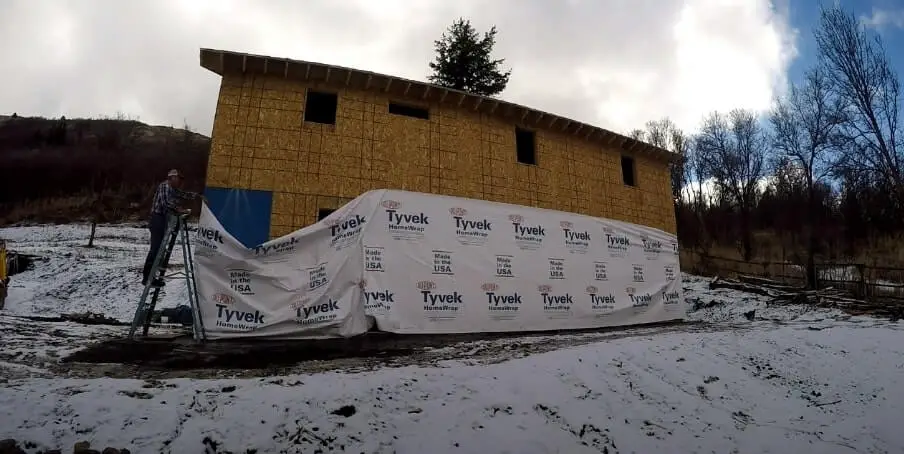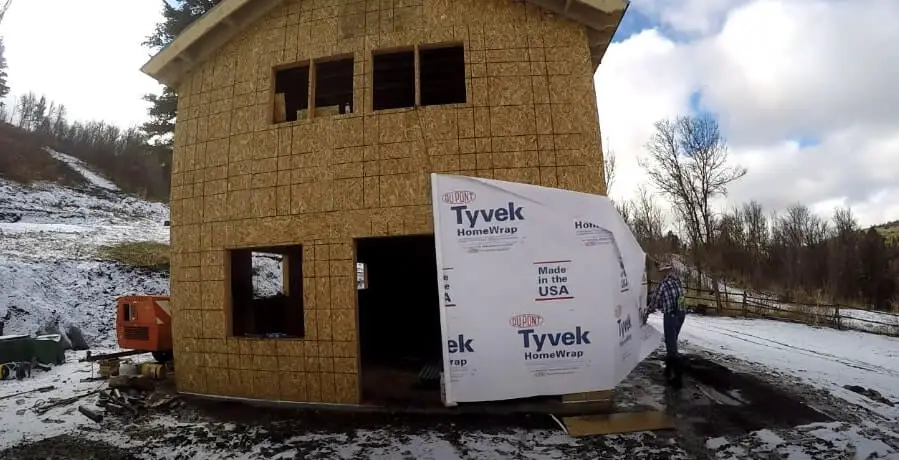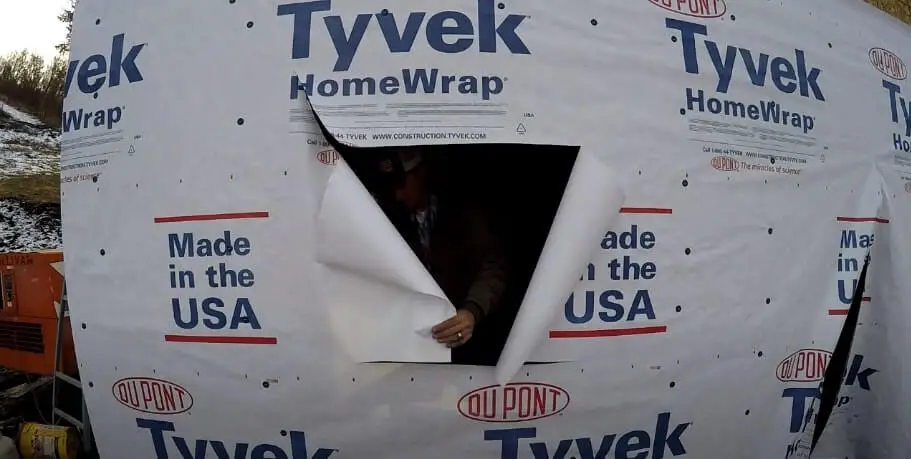House wrap can be exposed for two to six months, generally, and in some cases one-year maximum, depending on various factors such as house wrap material, type, quality, your area weather, and the installation method you used.
Here is a table to help you understand the situation better based on wrap type and material. Of course, weather and other factors will affect and increase or decrease the tolerance or exposure length, and I will discuss them in detail in the later sections.
| House Wrap Type | Material Composition | Exposure Duration |
| Polyethylene | Polyethylene (Plastic) | 3 to 4 months |
| Polypropylene | Polypropylene (Plastic) | 3 to 4 months |
| Spunbond | Polypropylene or Polyester | 3 to 4 months |
| Woven | Polypropylene or Polyester | 4 to 6 months |
| Bituminous | Asphalt or Bitumen-coated | 6 months to one year |
| Synthetic Fabric | Polypropylene or Polyester | 3 to 4 months |
| Foil-faced | Foil layer and other materials | 3 to 4 months |
| Perforated | Polyethylene or Polypropylene | 2 to 3 months |
Quick Jump
What Will Happen If You Leave the House Wrap Exposed?

A few years ago, my friend was building a new house, and he ran out of budget. So, he left the house wrap exposed and left it like that. Even with the budget, he didn’t bother using the proper means for the house wrap, exposing it for a few more months.
As you can guess, the result wasn’t great and cost him in many ways. In this section, I will discuss exactly what you’ll face if you leave the house wrap exposed for more than it can tolerate.
- You don’t want to replace the wrap or other underlying materials just after a few months. Still, it will happen as prolonged exposure to UV rays can cause the materials to break down, become brittle, and lose their protective properties.
- As a result, the wrap will lose its functionality and reduce durability and effectiveness in preventing moisture and air infiltration.
- Living in an area with too much wind can tear or detach the wrap from the building, creating openings for moisture and air to penetrate the structure.
- Besides, suppose you’re working on your house or any other construction work. In that case, Construction equipment or accidental impacts can also cause punctures or tears in the house wrap, compromising its integrity.
- It can become compromised whether you live in a rainy or snowy area, exposing the house wrap for a long time can lead to water damage, mold growth, and potential structural issues.
- Extended exposure to the elements can diminish its ability to control airflow, decrease thermal performance, and higher energy consumption for heating and cooling.
Not to mention where the wrap can lose its long-term durability, resulting in less optimal protection against moisture intrusion, air infiltration, and potential damage to the building envelope.
3 Factors Affecting House Wrap Exposure Duration
It would be really surprising if you and I used the same material, did the same installation process, and lived in a place where the weather is the same because it’s not.
Based on where we live, material composition, installation method, and exposure duration heavily affect the overall house wrap exposure limit and tolerance length. And I will discuss each factor in detail.

Factor #1: Material Types & Quality
It goes for every type of product out there, and in this case, house wrap, to choose the right type of material as it can significantly impact the exposure duration and overall performance of the house wrap.
Different materials come with different levels of durability, resistance to environmental factors, and intended usage. As you might already know, different types of material are used for house wraps, such as various ranges of plastic, spun-bond, woven, bituminous, bituminous, foil-faced, perforated, etc.
| House Wrap Material | Aspects | Effects |
| Polyethylene | Lightweight, flexible, moisture-resistant | Provides good moisture control and an air barrier. Susceptible to UV degradation if left exposed. |
| Polypropylene | Lightweight, tear-resistant | Offers excellent durability and moisture control. Can withstand exposure to UV radiation for longer. |
| Spunbond | Non-woven fabric, breathable | It provides moisture control while allowing some breathability. It may have lower UV resistance. |
| Woven | Woven fabric, stronger, tear-resistant | It offers increased strength and durability. It provides good moisture control but may be less breathable. |
| Bituminous | Asphalt or bitumen-coated | Provides enhanced moisture resistance. It can withstand prolonged exposure and offers UV protection. |
| Synthetic Fabric | The blend of polypropylene or polyester fibers | Offers good moisture control and durability. It can have varying UV resistance depending on the blend. |
| Foil-faced | Foil layer for increased reflectivity | Provides added thermal performance and moisture control. Susceptible to tearing and UV degradation. |
| Perforated | Perforations for controlled moisture passage | Balance moisture control and breathability. Requires careful installation to maintain effectiveness. |
The next significant thing after the tolerance limit is the overall quality of the product. Usually, when you choose a high-quality house wrap, these are designed to withstand prolonged exposure to the elements and are less likely to degrade or deteriorate quickly.
Another factor is that superior product quality often incorporates UV-resistant additives or coatings, which help protect the wrap from the damaging effects of prolonged sun exposure. Other than that, better quality means;
- They come with strength and durability, reducing the risk of tearing or damage due to high winds, construction activities, or accidental impacts.
- Not to mention their excellent water resistance, ensuring moisture does not penetrate the building envelope even during extended exposure.
- Have optimized vapor permeability properties, facilitating moisture evaporation and preventing condensation within the wall assembly.
So, ensure that your product and quality match these so that you don’t have to go through the hassle of changing or replacing the wraps again.
Factor #2: Weather in Your Region
I am a winter guy and usually like cold weather, and for that particular preference, I build my house in a region where most of the time it is winter. And it goes for many people who have a vice-verse preference, just like the rest of us.
No matter where we live, the elements of our home greatly depend on the region’s weather where you live. And that factor affects how long you can leave your house wrap exposed.
Here are some facts to help you understand this properly.
- If you live in a hot climate region like Florida, prolonged exposure to high temperatures can cause house wrap materials to degrade more quickly. Besides, excessive heat can break the wrap’s polymers, making it brittle and more susceptible to tearing or cracking.
- On the other hand, people from Alaska will relate to this, as freezing temperatures can make the wrap more rigid and prone to tearing, compromising its ability to provide effective moisture and air control.
- Rainfall and humidity are all connected or related. If you live in a rainy area, it has a high chance of high moisture, leading to water absorption and compromising the wrap’s ability to repel water effectively.
- Areas like Texas or Kansas have strong winds and severe storms, and it’s not good news for the exposed house wraps. Because wind can cause the wrap to flap, tear, or become dislodged from the building, and the combination of heavy rain, strong winds, and flying debris can significantly increase the risk of damage to exposed house wrap.
These are more or less the effects the exposed house wraps will face in different weather situations or conditions.
Factor #3: Method of Installation

Depending on the budget, type, material, and preference, you might choose a different installation process or method than me, which goes for all of us.
Based on the installation method and preference, these highly affect the exposure limit of your exposed house wrap.
I’ll go through a few examples and core things of installation methods to help you understand different situations.
You must first ensure the seal and overlap, which create a continuous barrier against moisture and air infiltration. If these areas are not adequately sealed, it can increase the risk of water intrusion and reduce the wrap’s effectiveness.
The second thing you should double-check is the fasteners and related attachments. Properly securing the wrap with nails or staples ensures its stability and prevents it from being dislodged or damaged by wind or other external factors.
Lastly, during the construction process, protect the house wrap from sharp objects, tools, or equipment that can puncture or tear the wrap.
Practical Tips For Protecting House Wrap While Exposed
Yes, you might face issues like a short budget or weather issues behind being unable to complete the installation process or having to leave the house wrap exposed for various reasons.
I have been in that situation, and I understand it completely. But nobody wants things to get wasted, broken, or unusable, like your house wrap, and there are some things you can do to protect the house wrap while it is still exposed.
- You can always consider and use a temporary solution, like getting a breathable tarp or construction-grade plastic sheeting to shield the house wrap from UV radiation, moisture, and debris.
- You must ensure that the joints and seams of the house wrap are properly sealed and overlapped so that water or debris or anything can’t get in there or damage it.
- If the construction process is ongoing, ensure that tools, equipment, and construction materials do not directly contact the exposed house wrap.
- Anything can happen to the house wrap while they are still exposed, so you must regularly inspect it for any signs of damage or deterioration.
Many things could happen, and sometimes, depending on the weather condition in your area, you might need to go the extra mile to protect your house wraps. It’s better to contact a consultant and ask for professional help in those cases.
Wrap Up
The bottom line is you can leave your house wrap exposed for a few months, but it’s better to get it fixed before something happens. Not to mention the long-term issues and overall quality drop the material will face for long-term exposed situations.
Get it fixed in under three months or less to maintain and gets the most out of it. Good luck!

Chino is an accomplished Founder and Home Improvement Contractor with a passion for transforming living spaces into beautiful, functional, and comfortable homes. With years of experience in the industry, he has established himself as a reputable expert in the field, earning the trust and admiration of numerous clients.
